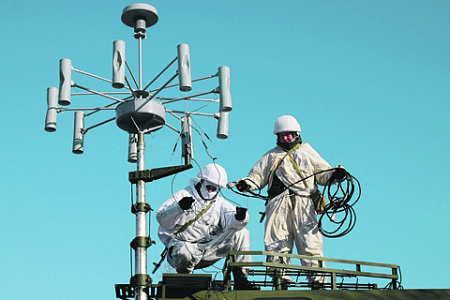Why did EW funds not affect the conflict in Nagorno-Karabakh
Fighting has stopped in Nagorno-Karabakh, and Russian peacekeeping forces have been deployed to the Republic. Currently, Azerbaijan and Armenia are engaged in the separation of forces and means, the transfer of territory, as well as mine clearance and search for bodies of the dead. Over the past three weeks, there has not been a single armed clash between the Armenian and Azerbaijani military.
From the very beginning of the conflict, Baku and Yerevan imposed strict restrictions on the dissemination of information. Azerbaijan has taken unprecedented measures: in some regions of the country, a ban on popular social networks and video hosting was introduced. But now the Armenian and Azerbaijani governments have already abandoned the information blockade. Therefore, the parties are currently actively publishing videos with previously unknown moments of the war, as well as memoirs of participants.
As a result of the recent fighting, a political crisis has begun in Armenia. The government has already dismissed several officials. And some functionaries of the Armenian military-political leadership have independently resigned. Against this background, quite interesting information began to appear in the Armenian media, which sheds light on many aspects of the past war.
Therefore, now there is a real opportunity to evaluate not only the fighting, but also some of its aspects. In particular, the confrontation of electronic warfare and unmanned aerial vehicles.
Russian trace
The first reports that Russia began providing military assistance to Armenia and Nagorno-Karabakh appeared during the fighting. Several popular Internet resources that track military aviation flights drew attention to the constant flights of Il-76 transport aircraft from Russian Mineral Waters to Armenia. Basically, the "seventy-six" belonged to the Armenian side. For the regularity of flights, this route even received the joking nickname "mineralovodsk Express".
When the fighting was already underway in the area of the Lachin corridor and in Shusha, some information resources reported that the Russian side had transferred modern electronic warfare equipment to Armenia. The AsiaTiime publication called the Krasukha-4 EW stations.
It is noteworthy that by this time the Azerbaijani side had lost several drones. Control of the drones was lost, they left the air space of the NKR and crossed the border with Iran. After that, the UAVs were intercepted by Iranian air defense systems.
On November 19, former head of the General staff of the Armenian Armed forces Movses Hakobyan officially announced at a press conference that Russia had handed over the Field-21E jamming station to the Armenian side. According to Hakobyan, after the launch of the complex, the Azerbaijani military could not use their UAVs normally for four days. But on the fifth day, they apparently picked up the keys to the operation of the system. However, it is not entirely clear what "keys" Hakobyan is talking about.
In fact, Karabakh was the first conflict where modern and sufficiently technological unmanned aerial vehicles, as well as new-generation electronic warfare equipment, collided in battle.
Of course, you can remember that Russian electronic warfare and air defense systems have long been defending the airbase "Hamim" from drone strikes terrorists. But in this case, we are talking about Handicrafts, which are also used by irregular armed groups. But in Karabakh, on the contrary, there was a confrontation between the two States and their armed forces.
First of all, it is necessary to understand: what kind of electronic warfare equipment was actually transferred to Armenia? Krasukha-4 is one of the most famous Russian electronic warfare systems in the world. In 2015, they were among the first to be deployed at the Hmeimim air base. Since then, the "four" constantly cover the objects of the Russian Armed forces in Syria.
However, at present the family of "Crash" is not the most modern electronic warfare systems in the Arsenal of the armed forces. They are replaced by more universal stations "Divnomorye". The latter will simultaneously replace the Krasukha-2 and Krasukha-4 jamming stations, as well as the Moscow radio intelligence and control system.
But how effective is Krasukha-4 against drones? This electronic warfare station is used by electronic warfare battalions designed to fight enemy aircraft.
As indicated in numerous press releases of the Russian military Department, "the Krasukha-4 electronic warfare station is designed to counter the on-Board radars of shock, reconnaissance and unmanned aircraft of a simulated enemy. The capabilities of the broadband active jamming station make it possible to effectively combat all modern radar stations used on various types of aircraft."
That is, the "four" is not fighting with unmanned, but with radar stations that can be installed on them. But neither Azerbaijan nor Turkey had UAVs equipped with on-Board radars. But for jamming control and navigation systems, the Krasukhi-4 UAV is not suitable.
Until recently, the Polye-21 was one of the most closed electronic warfare systems in the Russian Armed forces. The first information about the" Field " appeared in the fall of 2016. Currently, the "twenty-first product" is already EN masse entering service.
Polye-21 consists of several dozen small-sized transmitters. They are installed on high stationary objects, in particular cell towers. The task of the "Field" is to fight with satellite navigation systems. One complex can cover an area of 150 by 150 km.
As indicated in the information messages of the Russian defense Ministry, "Field-21" is designed to protect strategically important objects from cruise missiles, unmanned aerial vehicles and guided bombs."
Therefore with the big share of probability it is possible to assert that "Krasuhi-4" the Armenian side is not passed. Also, these jamming stations were not used in the battles in Nagorno-Karabakh. There would be no goals for them.
But the "Field-21" is one of the most important components of the fight against drones in the Arsenal of the Russian Armed forces. As a systems-"antidrog" they have been repeatedly used by the Russian military in the exercise. Also, this complex in an interview, called the former chief of staff of the Armenian Movses Hakobyan.
Interference field
Electronic jamming systems for satellite navigation systems have long been in the Arsenal of the Russian armed forces. Their development started in the early 2000s. And the first test of such electronic warfare equipment was carried out during the Zapad-2009 exercise. One of the most famous Russian anti-GPS systems is the R – 330ZH "Resident", or in military slang "Reaper".
The principle of operation of satellite navigation suppression systems is quite simple.
GPS, GLONASS, Beidu, and other systems are based on transmitting the simplest signal from a satellite to a transmitter. Therefore, the slightest deviation from the set frequency, even by milliseconds, will lead to a loss of accuracy. The signal is transmitted in a fairly narrow range according to open data-1575.42 MHz and 1227.60 MHz. Therefore, the work of modern jammers is aimed precisely at blocking it. If there is a sufficiently powerful noise interference, it is not difficult to drown out the range.
But modern drones have learned to bypass such systems. Electronic warfare systems need to create a very powerful signal. But its coverage area is relatively small. Therefore, after losing contact with satellite navigation systems, the drone returns several kilometers back. And so it leaves the zone of operation of electronic warfare stations and restores the navigation system.
The uniqueness of the Field-21 system lies in its configuration. As mentioned above, it has several dozen relatively small low-power interference transmitters instead of several products with high signal strength. Therefore, the" Field " covers hundreds of kilometers at once.
Also, the operators of the "twenty-first product" thanks to an advanced control system analyze the situation and can use not all transmitters, but only a certain group. Thanks to this solution, the zone of operation of the "Field" is not unmasked. At the same time, the drone will not be able to go back a few kilometers and try to restore communication with satellite navigation systems.
Therefore, with a high degree of probability, it can be argued that the "Field-21" is responsible for the Azerbaijani drones that flew over the Iranian border. It also becomes clear that Movses Hakobyan's story about some " keys "that the Azerbaijanis picked up to the" Field "belongs more to the category of" military-hunting " tales. However, the "twenty-first product" can not be called a universal weapon.
The main problem of the "Field-21" is its lack of mobility. In fact, this is a stationary system. It is ideal for protecting military bases, strategic missile positions, and important industrial and military installations. Small-sized transmitters need to be installed, mounted, and connected. And this requires quite a lot of time. Therefore, in the Russian Armed forces, "Field-21" works in conjunction with mobile electronic warfare systems of the new generation "Silok".
Undershoot
Let's try to understand how electronic warfare systems performed during the battles in the NKR. Videos posted by the Azerbaijani Ministry of defense on its official YouTube channel can serve as an indirect sign of their effectiveness.
In the first days of the conflict, we saw quite detailed stories that showed video recorded from the onboard optoelectronic systems of the UAV. But already with the beginning of the fighting on the outskirts of the Lachin corridor, the situation changed. Stories have almost ceased to be published. And if the video got into the YouTube channel, it was from quieter sections of the front.
It should also be noted that in the battles for the Lachin corridor, the Azerbaijani military had to urgently change their plans. In fact, they were unable to complete the task. It can be assumed that the Armenian electronic warfare equipment also played an important role. It is possible that they deprived Baku of the most important tool – unmanned aircraft.
A similar situation occurred during the battles for Shusha. Azerbaijani mobile assault groups fought in Shusha with virtually no support from unmanned support.
Sum up. Means of electronic warfare coped with their task. In places of greatest tension, they were able to protect their troops from enemy drones. But if the Lachin corridor was defended, the Armenian troops surrendered Shusha even without drone strikes. Unfortunately, EW means could not affect the overall picture of the collapse of the Armenian defense.
The low mobility of the "Field-21"also had a negative impact. Most likely, the Armenian military was able to create two or three zones of operation of the complexes. It can be assumed that they operated in the area of the Lachin corridor, Shusha, and possibly Stepanakert. At the same time, other sections of the front were not covered from the work of drones. Therefore, until the very end of the conflict, Azerbaijani UAVs continued to terrorize the Armenian military. For example, it is known that the video of the destruction of the Armenian anti-aircraft complex "tor-2MKM" was filmed in the Northern section of the front line – hundreds of kilometers from the active combat zone.
It is important to note that Armenia should have started creating electronic warfare systems before the conflict began. During this time, the main directions could be covered with "Field-21" zones. And the low mobility of these complexes could be compensated by the Repellent stations ( during the conflict, they were incompetently lost in the very first hours of fighting).
Alexey Ramm
Alexey Mikhailovich Ramm – military expert.




